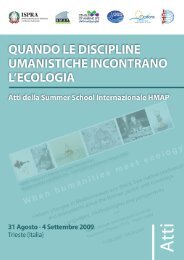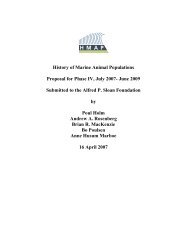The Danish fisheries c.1450-1800. Medieval and early modern ...
The Danish fisheries c.1450-1800. Medieval and early modern ...
The Danish fisheries c.1450-1800. Medieval and early modern ...
You also want an ePaper? Increase the reach of your titles
YUMPU automatically turns print PDFs into web optimized ePapers that Google loves.
caught in large numbers <strong>and</strong> then to become<br />
extinct within a decade. <strong>The</strong> fiord was now kept artificially open, <strong>and</strong> the fiord was again<br />
occupied by plaice <strong>and</strong> eel.<br />
<strong>The</strong> herring fishery was mainly conducted by large <strong>and</strong> very expensive pound nets<br />
owned by urban merchants of Aalborg. <strong>The</strong> fishery seems to have been fully developed by the<br />
<strong>early</strong> sixteenth century when in 1518 the royal privileged purchase (kongekøb) amounted to<br />
528 barrels of herring. 4 In the 1600s the annual kongekøb oscillated between 400 <strong>and</strong> 900<br />
barrels in periods of good harvests. As 1518 was not a particularly good year for Aalborg’s<br />
trade, the harvesting potential of the fiord seems already to have been exploited to the full by<br />
the <strong>early</strong> sixteenth century. This impression is reinforced by the intense legislative effort on<br />
the part of the King to control fishing effort by strict regulations of mesh size <strong>and</strong> the<br />
allotment of fishing grounds to a limited number of pound nets.<br />
<strong>The</strong> sources of the kongekøb privilege for the seventeenth century <strong>and</strong> the export<br />
trade figures of Aalborg’s exports to the Baltic for the eighteenth century give an impression<br />
of the periodicity of the fishery (Figures 5 <strong>and</strong> 6). <strong>The</strong> fishing was depressed in the <strong>early</strong><br />
1600s <strong>and</strong> peaked 1610-20. A lacuna of the 1620s prevents us from following the impact of<br />
the 1624 flood, but the figures from 1631 reveal a fishery which is being built up to a new<br />
peak in the 1640s, with a new decline by 1654. <strong>The</strong>n followed a long depression which is<br />
4 Jan Kock, Næringsliv og samfærdsel. Aalborgs historie I, (Aalborg, 1992) 355.






